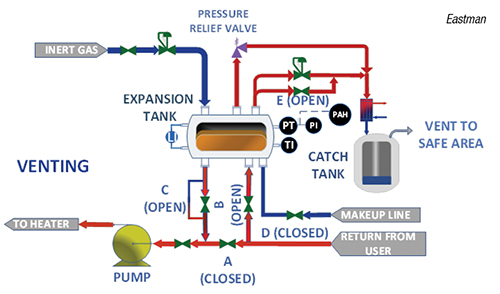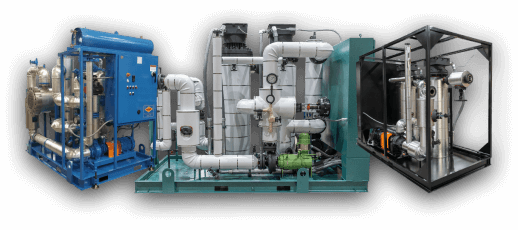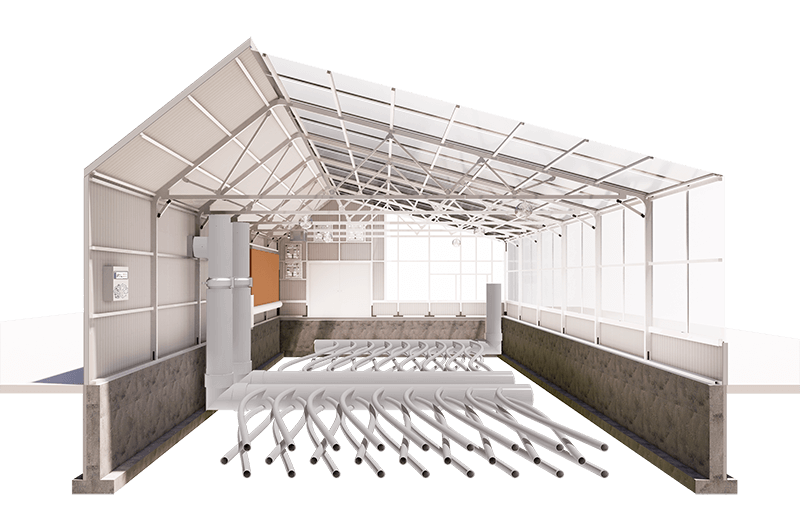DVS Heat Transfer Systems: The Future of Energy-Efficient Industrial Heating Solutions
Wiki Article
The Duty of Heat Transfer Solutions in Sustainable Power Solutions for the Future
Heat transfer systems are essential in the pursuit for sustainable energy solutions. They maximize thermal energy administration, improving the performance of eco-friendly innovations. By using devices like convection, conduction, and radiation, these systems minimize energy losses. Their role in solar thermal and geothermal applications is specifically considerable. As innovations emerge, the capacity for further innovations elevates important concerns concerning future power techniques. What developments will form the landscape of sustainable power?Understanding Heat Transfer Solutions

The Value of Thermal Power Monitoring
Effective thermal energy management is necessary for maximizing energy effectiveness and minimizing waste in different systems. By controling temperature and optimizing Heat transfer procedures, organizations can markedly minimize power usage and operational expenses. Efficient management entails the application of innovative modern technologies and methods that monitor and control thermal problems within systems, making sure that energy resources are used effectively. On top of that, appropriate thermal power management adds to minimizing greenhouse gas exhausts, aligning with global sustainability goals. It likewise improves system integrity and performance, leading to improved product high quality and longer equipment life expectancy. Ultimately, prioritizing thermal power management is an important action in the direction of producing a lot more lasting energy options and cultivating a responsible technique to power usage in domestic and commercial contexts.Applications of Heat Transfer in Renewable Power
While different renewable power sources promise sustainability, the reliable application of Heat transfer plays an important role in their performance. In wind energy systems, Heat transfer is used for turbine part cooling, improving efficiency and long life. Geothermal power depends on effective Heat exchange between the earth's subsurface and the liquid distributing in the system, optimizing power removal. Biomass energy procedures likewise benefit from Heat transfer, as it aids in converting organic products into functional fuel with pyrolysis and gasification. Furthermore, in hydropower, keeping perfect temperature levels in reservoirs can boost power outcome. Each of these applications shows the crucial significance of Heat transfer systems in boosting renewable resource innovations, ultimately adding to an extra sustainable power future.Enhancing Solar Thermal Power Effectiveness
As solar thermal power systems continue to develop, enhancing their performance has actually come to be vital for maximizing power outcome. Advancements in Heat transfer innovations, such as boosted thermal storage space products and cutting-edge Heat exchangers, play a significant duty in improving efficiency. By utilizing advanced products that have premium thermal conductivity, systems can move and catch Heat better. Additionally, incorporating radar that comply with the sunlight's course assurances that collectors obtain excellent solar exposure throughout the day. Making use of nanotechnology in solar absorbers can further enhance energy absorption rates. Including automated control systems helps take care of and manage temperatures power circulation successfully, leading to reduced losses and improved total system effectiveness. These improvements lead the way for more lasting solar thermal power solutions in the future.Geothermal Heating: A Sustainable Service
Geothermal home heating offers a sensible alternative for sustainable power, supplying considerable environmental advantages with minimized greenhouse gas emissions. Its performance and cost-effectiveness make it an appealing alternative to traditional heater. Obstacles associated to application needs to be resolved to maximize its potential influence.Ecological Advantages of Geothermal
Traditional home heating methods add substantially to greenhouse gas emissions, geothermal home heating provides a compelling option that minimizes environmental influence. By taking advantage of the Planet's inner Heat, geothermal systems utilize a renewable energy resource, considerably lowering dependence on fossil fuels. This technique creates minimal carbon exhausts, making it a cleaner choice for residential and business heating. Additionally, geothermal systems promote power effectiveness, as they call for less power compared to standard heater. DVS Heat Transfer Systems. The usage of geothermal power additionally assists in decreasing air pollution, improving local air top quality and public health. As a lasting solution, geothermal home heating supports environment modification mitigation initiatives, positioning itself as an important component in the shift towards a greener futureEfficiency and Cost-Effectiveness
Exactly how does geothermal heating determine up in terms of efficiency and cost-effectiveness contrasted to standard furnace? Geothermal heating shows premium performance, frequently accomplishing a coefficient of efficiency (POLICE OFFICER) of 3 to 5, indicating it generates 3 to five units of Heat for every system of electrical energy eaten. This efficiency converts into lower operating expense, particularly in areas with secure geothermal sources. Initial setup costs can be greater than traditional systems; however, lasting savings on power expenses and minimized upkeep costs can counter these ahead of time financial investments. Additionally, many governments incentivize geothermal systems via refunds and tax credit scores, boosting their cost-effectiveness. On the whole, geothermal heating becomes a financially practical and sustainable alternative to even more conventional home heating options.Execution Obstacles and Solutions
Numerous challenges can impede the prevalent execution of geothermal heating systems, regardless of their clear benefits as a sustainable energy service. High initial setup expenses frequently deter home owners and capitalists, making financing a substantial barrier. Furthermore, the geographical restrictions of appropriate geothermal websites limit availability in particular regions. Neighborhood policies and permitting processes can likewise complicate project advancement, leading to hold-ups. Additionally, public recognition and understanding of geothermal systems continue to be low, impeding acceptance. To address these obstacles, targeted education and learning campaigns can enhance open secret, while federal government motivations might ease monetary burdens. Collaborating with local authorities to simplify policies might help with smoother task approvals, ultimately advertising the fostering of geothermal home heating as a sensible, lasting energy option.Innovations in Heat Transfer Technologies
Developments in Heat transfer modern technologies play an essential role in improving energy efficiency and sustainability. Advanced Heat exchangers and phase change products go to the forefront of these growths, offering significant renovations in thermal monitoring. These modern technologies not just maximize energy use but also add to decreasing ecological effect in different applications.Advanced Heat Exchangers
Advanced Heat exchangers play a crucial duty in improving power performance across various applications in lasting power remedies. These devices facilitate the transfer of Heat between 2 or more fluids, substantially lowering power intake in procedures such as industrial heating, air conditioning, and power generation. Technologies in products and style, such as making use of nanofluids and compact arrangements, have led to enhanced thermal performance and minimized size demands. Additionally, innovations in digital monitoring and control systems enable maximized operation, more boosting efficiency. By minimizing waste Heat and making best use of power recovery, advanced Heat exchangers add to lower carbon footprints and support the shift toward environmentally pleasant modern technologies. Their proceeded development is essential for achieving global energy sustainability objectives.
Stage Modification Materials
The combination of phase adjustment products (PCMs) YOURURL.com right into Heat transfer read the article innovations stands for a significant improvement in energy administration and effectiveness. PCMs take in and launch thermal energy during their stage modifications, allowing reliable temperature guideline in building materials and power systems. By saving excess Heat during top periods and releasing it when need increases, PCMs add to load moving and power conservation - DVS Heat Transfer Systems. This capability improves the efficiency of renewable resource systems, particularly in solar thermal applications. Additionally, PCMs can enhance the thermal comfort of indoor environments, decreasing reliance on conventional heating and cooling approaches. As innovations in PCM solutions proceed to emerge, their role in sustainable power remedies is poised to grow, offering promising avenues for future study and application
Future Potential Customers for Heat Transfer in Sustainable Power
As the demand for lasting power options continues to climb, the function of Heat transfer systems is coming to be progressively important fit future innovations. Innovations in materials and styles are anticipated to improve efficiency in Heat transfer, minimizing power losses in various applications. The assimilation of advanced thermal storage space systems, such as stage modification materials and thermochemical storage space, will enable much better administration of power resources. Research study right into nanofluids and biomimetic Heat exchangers may even more optimize thermal efficiency. Moreover, the adoption of wise modern technologies will certainly allow for real-time monitoring and flexible control of Heat transfer procedures. These improvements are poised to significantly add to the total performance and sustainability of energy systems, leading the way for an extra energy-efficient future.Often Asked Concerns
How Can People Carry Out Heat Transfer Solution in the house?

Individuals can implement Heat transfer systems in your home by installing energy-efficient appliances, utilizing radiant heat, and maximizing insulation. These actions boost energy performance, reduce costs, and promote lasting practices in domestic environments.

What Are the Costs Connected With Setting Up Heat Transfer Solutions?
The expenses related to mounting Heat transfer systems differ commonly, typically including devices, setup labor, and maintenance. Elements such as system type, home size, and local laws greatly affect the total expense included.Are There Government Motivations for Heat Transfer System Installations?
click here for more Government incentives for Heat transfer system installments vary by area and can include tax obligation rebates, credit scores, and grants. These financial benefits intend to encourage fostering, ultimately advertising energy efficiency and lowering environmental effect within areas.Exactly How Do Heat Transfer Equipments Effect Energy Expenses?
Heat transfer systems significantly affect energy expenses by optimizing power efficiency. By improving the transfer of Heat, these systems lower energy intake, resulting in lower utility costs and developing a more sustainable strategy to energy administration.What Maintenance Is Needed for Heat Transfer Systems?
Upkeep for Heat transfer systems includes routine inspections, cleaning of components, examining fluid levels, making certain proper insulation, and replacing used components. These tasks assist keep efficiency, avoid failures, and lengthen the system's functional lifespan.These systems assist in the activity of thermal energy from one medium to one more, allowing the transfer of Heat for energy, air conditioning, or home heating generation purposes. Geothermal power relies on effective Heat exchange in between the planet's subsurface and the liquid circulating in the system, maximizing energy extraction. Furthermore, geothermal systems promote power performance, as they call for much less power contrasted to standard home heating systems. Advanced Heat exchangers play a crucial role in enhancing energy effectiveness across various applications in lasting power services. Heat transfer systems notably affect power expenses by enhancing energy performance.
Report this wiki page